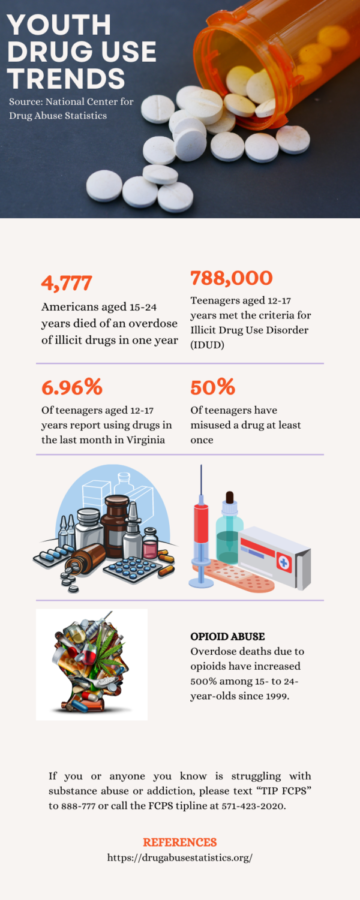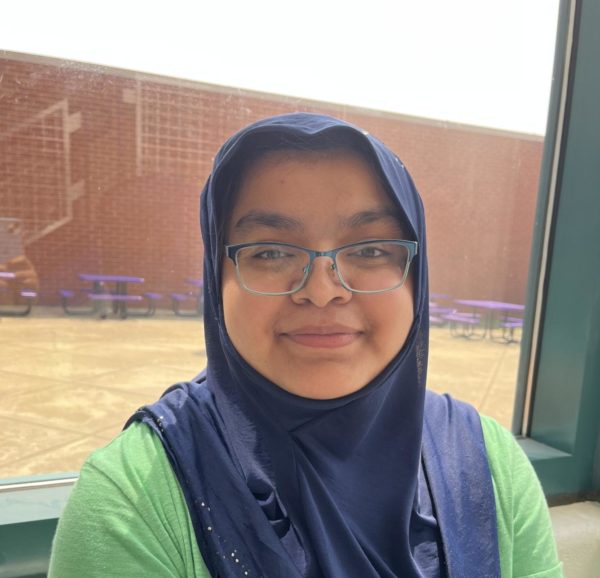Spike in student drug use demands awareness, reevaluation of existing policies
Drug use trends indicative spikes in use of all drugs, including marijuana and heroine.
May 15, 2023
Over 590,000 teenagers aged 12- to 17-years-old nationally have used an illicit drug in the last month, according to the National Center for Drug Abuse Statistics. The same study found that 6.96% of teens in Virginia regularly use drugs.
In recent months, news stories of fentanyl-laced substances have permeated numerous communities, highlighting the impact of drugs on adolescents. In January, emergency personnel arrived at Wakefield High School to what Arlington police later said was an apparent drug overdose, and in the month before, Prince William County police responded to three overdoses involving teenagers in the span of a week.
At CHS and other schools throughout the nation, students learn about substances—such as marijuana, tobacco and opioids—through health classes, yet external influences still lead some teens to continue vaping, smoking or using illicit substances.
“I think what we’re seeing trend younger and younger is exposure with a lack of understanding of what it is,” principal Dr. Amy Goodloe said. “There’s more exposure at younger ages, and we need to build a capacity and awareness amongst students and, really, amongst parents to know what they’re seeing. Being somebody who works in schools, I’ve had an understanding and exposure to many of those things in classes and professional development that I take, but as a parent, you might not be aware of some of the things that are out there.”
Dangers and health repercussions
Some dangers of substance use are well-known. For example, tobacco use leads to lung disease, opioids have damaging neurological effects and injection drugs allow for infections. However, some substances that are categorized as “safer” for teen use pose lesser-known dangers.
Adolescents using e-cigarettes, commonly known as vapes, are not inhaling water vapor but liquids containing nicotine, a mood-altering chemical that creates a momentary “high.” Not only is nicotine dependence a result of nicotine use, but it can also damage the lungs and harm brain development, which causes attention deficits and other psychiatric disorders.
Additionally, just two milligrams of fentanyl, a synthetic opioid, can kill one person. Fentanyl is most often prescribed to relieve pain from surgeries or other medical situations, yet it killed over 79,000 individuals in the US in 2022.
“I think for the individual, it just kind of slows their progression because if they have goals of attending college or going to a trade school or working, use of drugs impacts every aspect of your life,” social worker Dana Condemi said. “It might delay or detour you from reaching your goals, and that has an impact on the person, and when that impacts a person, it obviously has the ripple effects in the community because they’re missing out on a college student, a good worker, whatever it might be.”
Not only does drug use endanger teens, but withdrawal when recovering from addiction can also have adverse effects. Detoxing can cause physical symptoms like headaches, nausea and fever and manifest into other symptoms like insomnia, easy irritability and loss of appetite. Generally, the nature of the brain gravitates toward things that make a person happy, including the buzz associated with a drug, and when that buzz stops or is taken away, the withdrawal symptoms worsen.
“In a sense for a lot of people, it’s the only thing they can turn to because they feel like they don’t have people or the proper resources to rely on,” senior Ali Rahim said. “Drugs are the only thing that can make them feel safe.”
Mental health awareness
The consequences of drug use are not limited to adverse health effects. According to the Mental Health Foundation, stimulant drugs such as cocaine and ecstasy can increase the risk of anxiety and depression, while hallucinogenic drugs such as magic mushrooms have the potential to exacerbate existing mental health problems.
“From my position here, we are seeing a lot more people with significant mental health concerns,” psychologist Kristina Crawford said. “There’s always been anxiety and there’s always been depression, and there’s always been that stress. It seems over the last couple of years it has really been intensifying after Covid, but I think it was already on the uptick before Covid and I think Covid just blew it all.”
For students specifically, drug use can have a detrimental impact on academic performance. Research by Just Think Twice, an official website of the U.S. government, revealed teens who use and abuse drugs have lower grades, a higher rate of absences from school and extracurricular activities and an increased chance of dropping out of school, all factors which prevent them from fulfilling their potential and achieving current and future success.
“[Drug use] could depend on what healthy coping skills or mechanisms individuals might have to be able to deal with stress or anxiety, or other things that are going on in their lives, so really, I think of it as more of a maladaptive coping skill,” Condemi said. “For many of us when we get stressed, we have healthy ways to manage the stress, whether it’s to distract ourselves by reading a book, going on a run, working out, knitting, drawing or biking. Some people don’t have that healthy coping skill, and they might lean towards the use of drugs to try to numb or redirect whatever they might be feeling.”
For concerned or impacted parents or members of the community, FCPS recommends a plethora of ways to communicate with teens in regard to drug use and abuse, including the setting of clear family rules and expectations, discussing the ‘why’ behind the use, and if necessary, getting them the treatment they need to stop using or overcome addiction.
“I think relationships are important,” assistant principal Zachary Winfrey said. “Trying to talk to students when they do get in trouble with the stuff, and making sure they have someone to talk to or be open with, without feeling like they’re risking getting in bigger trouble.”
Policies and consequences
Even though consequences have been implemented to discourage students from drug use in and out of schools, the administration has also attempted to prevent students from turning to drugs by offering direct help. According to School Resource Officer LM Leisey, students have been provided with tiplines or numbers that they can text or call anonymously to report drug use or speak about issues regarding drugs.
However, in order to better ensure the safety of students and staff, some administrators prefer to see stricter protocols in addition to direct assistance.
“I think we’ve been pretty relaxed and lenient with some of the policies and I would like to see the SR&R be a little bit more strict,” Winfrey said. “Kids need to understand the risk that they’re taking, and they’re not only impacting themselves, but they’re impacting the students who want nothing to do with it because it’s happening in restrooms. Students are forced to encounter this all the time.”
Concerns about student drug use are rooted in the belief that they are not sufficiently informed about the dangers of some drugs, particularly fentanyl. According to the Drug Enforcement Administration, even inhaling airborne fentanyl powder can lead to harmful effects. Fentanyl poisoning typically occurs when teens and young adults unknowingly consume fentanyl-laced pills that are sold under the guise of less powerful drugs.
Parents are not the only adults concerned about awareness of drug effects. Per the National Center for Education Statistics, worries among administrators about the level of security at schools has increased safety measures in most public schools around the country.
“Unfortunately, I think one of the things that needs to change is the funding that we have for security,” Winfrey said. “We don’t have enough. We have five security staff members for a building full of 4,000 people.”
While security staff members require less suspicion to search students, police officers present at scenes of drug use need probable cause, according to Leisey, and suspicion based on odor no longer qualifies as one of them in Virginia in the case of marijuana use. Policy changes are also reflected in the fact that possession of marijuana at school is no longer a criminal offense and is instead classified as a Class 2 Misdemeanor, which is punishable by a maximum of six months in jail and a fine of $1,000 in Virginia. Additionally, according to Virginia law, anyone under 21 who possesses marijuana products will be subject to a civil penalty of no more than $25 and encouraged to take a substance abuse treatment or education program.
“Back when I was in high school, if you were caught with marijuana at school, you went right to the hearings office for a recommendation for expulsion from the school,” Winfrey said. “That was a no-tolerance policy, but I think that’s pretty extreme. So I’m not saying that’s what needs to happen, but because vaping is such an epidemic, there really needs to be some other consequences in place that a kid will think twice or three times about what they’re about to do.”
Resources
In an attempt to mitigate the issue of drug use, a plethora of resources are available both inside and outside of school for impacted students. Allyson Jacobi is the Substance Abuse Prevention Specialist (SAPS) for FCPS, and one of the many resources recommended by Condemi.
“A SAPS is assigned to work with students in our school,” Condemi said. “So if we have a student who’s either been identified as using substances or is challenged at trying to quit substances, we can always use these specialists to work with them and link them to community resources.”
Resources accessible to students outside of school include the Sharon Bulova Center for Community Health, which is located in Fairfax and includes a Crisis Response Center along with treatment for those struggling with substance abuse and mental health. The Chris Atwood Foundation is a non-profit providing a wide range of similar services, and the Northern Virginia Family Services (NVFS) is another resource accessible to students and their families that offers many programs, including mental health youth services and multicultural mental health services.
Additionally, the Fairfax-Falls Church Community Services Board hosts two weekly virtual concurrent groups in order to support individuals on their journey to recovery: “Heads Up,” a group for teens between the ages of 14-17 who are working through emotional, mental health or substance abuse challenges, and “Talk It Out,” a group providing a variety of resources to parents and guardians of individuals impacted by substance abuse or other issues.
“I just think it would be great if students who are struggling come and find one of us, or find and talk to their school counselor,” Condemi said. “Reach out to the school psychologist or school social worker. We’re in the building to be able to help and provide any support that students need, so if anyone is out there and they are struggling, whether it’s with mental health or substance use, they should let us know.”







